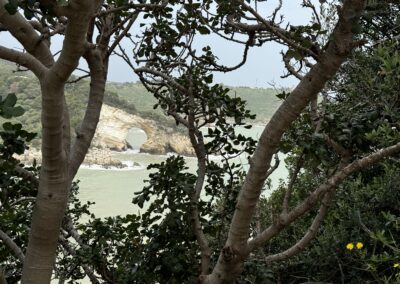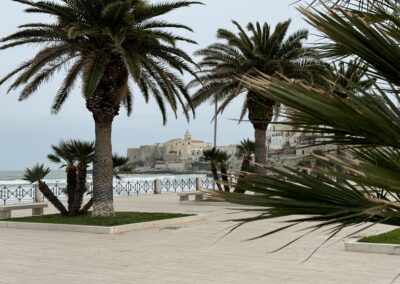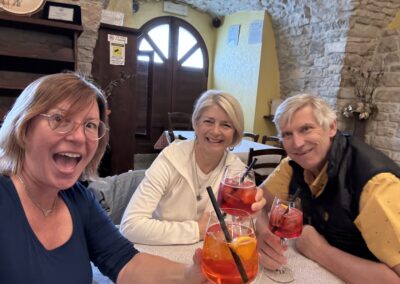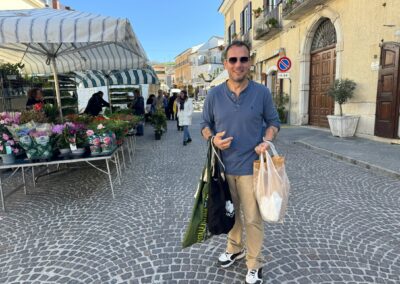Italy in full colour
From Rural Villages to Ancient Wonders
pizza
in puglia
Our home for two months
We finally arrived in Puglia, Italy—our home for the next seven weeks at a co-living space centred on permaculture, community, and slow living. On our first night, we were taken out to the local restaurant for pizza, and were instantly reminded of how deeply Italians understand the finer things in life. I was thrilled for wholesome food and the chance to settle into our new temporary life.
Then I promptly caught Covid.
After five bedridden days feeling like a Victorian waif with consumption, I finally felt well enough for a gentle evening walk around Roseto Valfortore, our charming hilltop town.
Italy continues to surprise me with its wildlife—I’d spotted a badger and a hedgehog earlier on a walk (unfortunately both pushing up daisies), and Randy outdid me by seeing an actual golden jackal. He couldn’t back it up with a photo, so I had to take his word for it.
One of my favourite discoveries was the 250-year-old bakery (which was once the village’s communal oven.) It’s still fired with wood and straw, and the kind baker spontaneously gave us a personal tour. Their massive loaves cost only €3 per kilo and are pure heaven dipped in a plate of olive oil.
Every Saturday we visited the the local market to pick up fresh produce, have coffee and a pistachio cornetto, and sample the best truffle cheese imaginable, called “Catchacavallo” meaning “catch the horse.”
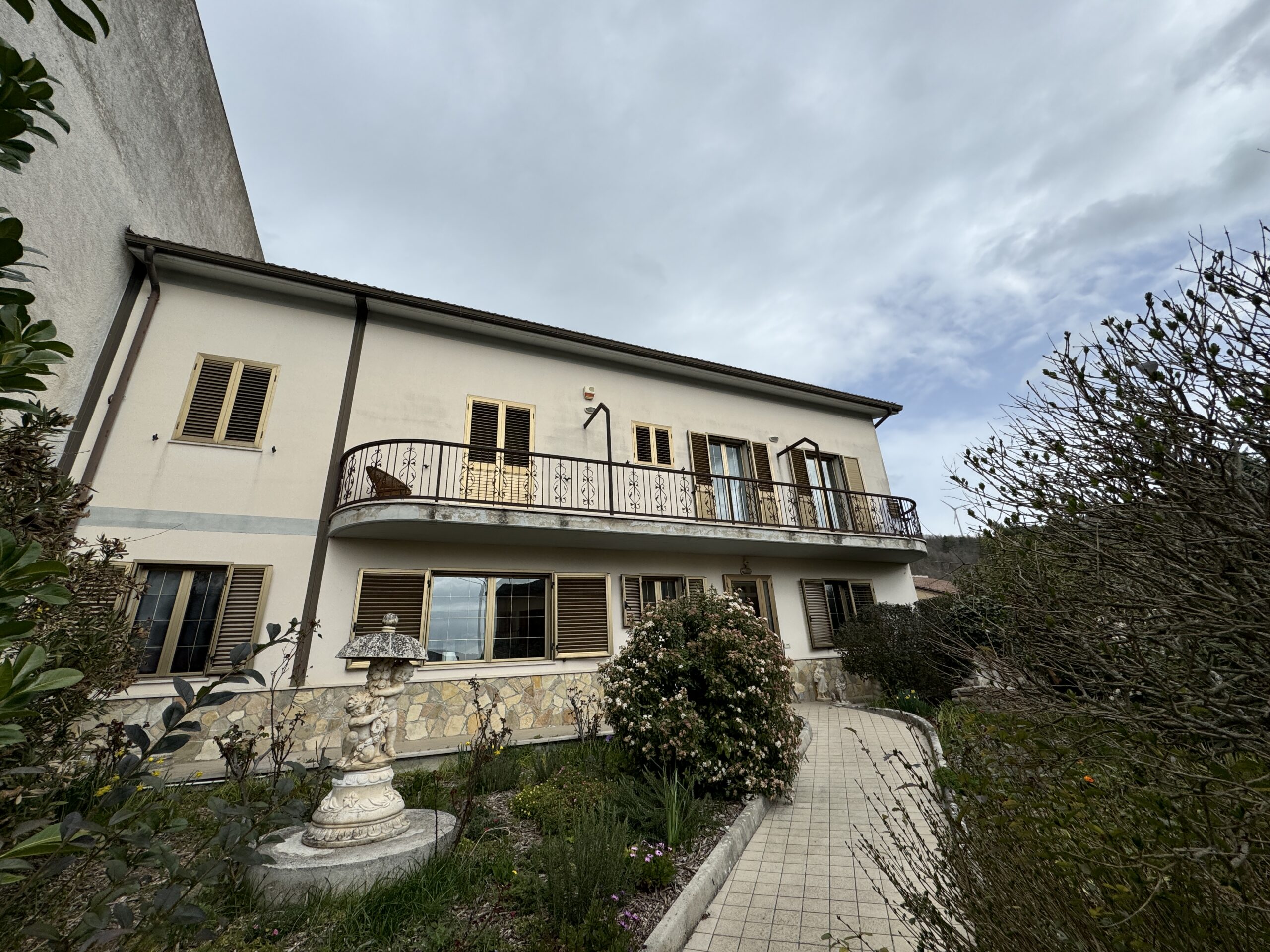
Exploring
the Gargano
Coastlines, Caves, and Easter Traditions
We had a little getaway, and met up with my fabulous friends Leslie and Graham in Vieste—a whitewashed seaside town perched on the spur of Italy’s “boot.” With Easter approaching, the whole region buzzed with energy. We hiked goat trails down to the beach, weaving between enormous sea caves carved into the limestone cliffs. Many beaches here are privately owned, so the ones we could access felt like little treasures.
On the way back to Roseto, we stopped in Peschici, another charming town with winding alleys and views that don’t seem real. The next day the village held its Easter procession, followed by the ultimate cultural experience: a homemade pasta workshop with a local nonna. The best part? We got to enjoy the pasta after the workshop!
Life at
La Vita Sukha
Community, Cooking, and Preparing to Move On
As our time at La Vita Sukha wound down, gratitude settled over everything we did. Seven weeks in one place feels like an entire chapter—birthdays celebrated, goodbyes shared, and long communal dinners that turned strangers into familiar faces. One evening, a countryside restaurant opened just for us. We were the only guests all night, and every dish was presented as if grandma herself had made it.
Meanwhile, Randy spent many mornings in the garden with Liz, the owner of the property. She’s carrying on her family’s legacy by reviving her late father’s beloved garden, but with a fresh focus on organic permaculture. Randy helped prep beds, turn soil, and bring neglected corners of the land back to life. Watching the garden evolve—slowly, intentionally—felt like witnessing a phoenix rising from the ashes.
Back at the villa, the wood stove became my unlikely companion. I simmered a pot of steaming soup like some momma homesteader while spring was taking her sweet time arriving. Bit by bit the days warmed, the trees blossomed, and we felt that quiet voice that said it’s time to move on.
Soon enough, the time to leave arrived. We packed our bags once more, shed some tears saying goodbye to Liz, and bounced our way over washed out roads towards Napoli.
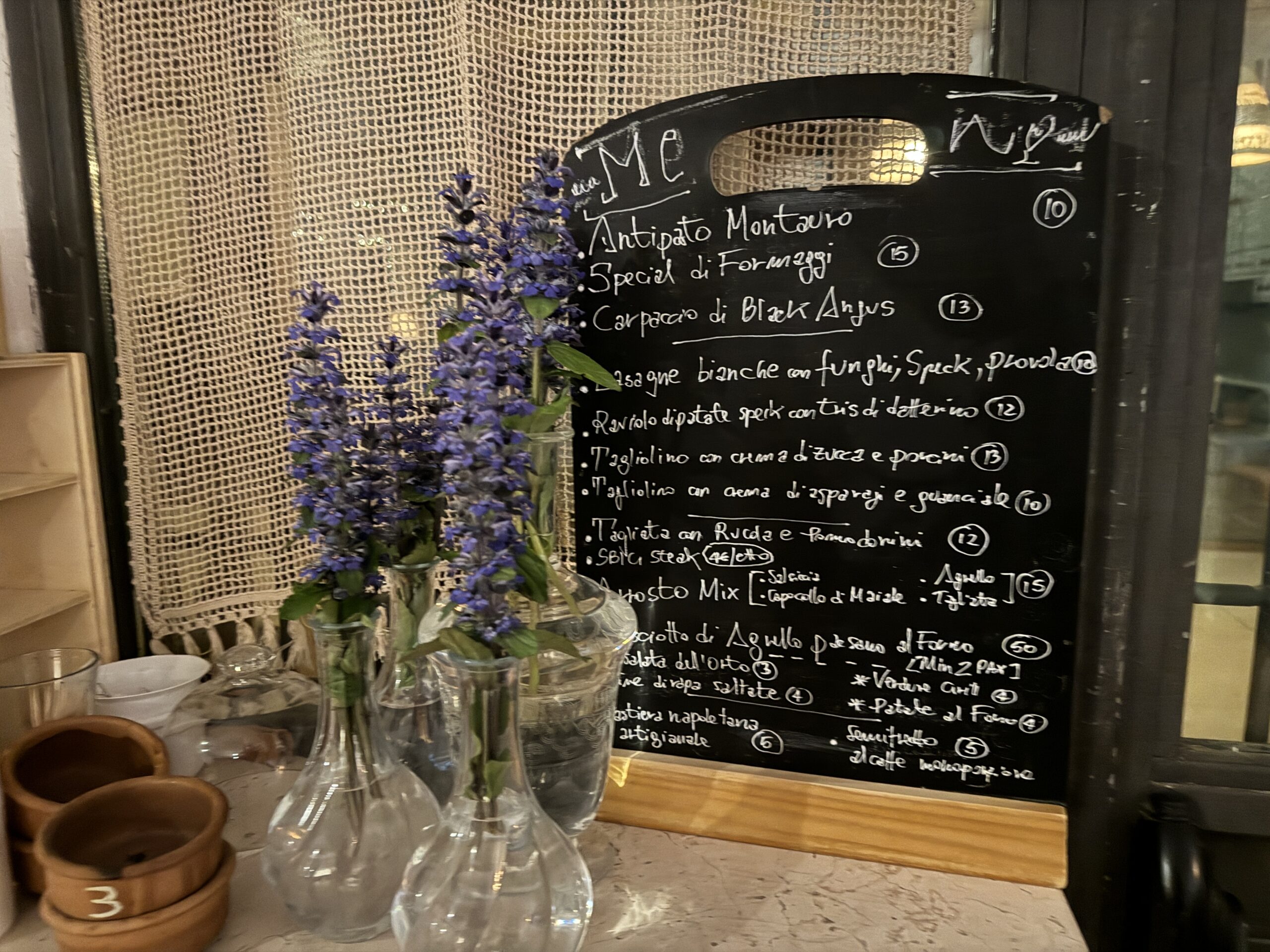
Napoli to
Pompeii
Chaos, Pizza, and Ancient Ashes
Hello Napoli!! Leaving La Vita Sukha was emotional—we’d been there long enough to form routines, friendships, and a deep fondness for the place—but the littlest hobos must keep wandering. Our new home base came with a very cool courtyard, and of course we celebrated our arrival the only appropriate way: by heading out for pizza in the neighbourhood.
Napoli is crazy. We were dodging cars and scooters driving way too fast down very narrow streets. Two girls, aged about nine, were driving down the road in what I can only describe as a pink Barbie jeep. I instantly regretted not planning more than a brief stay.
The next morning we set off early for Pompeii, fuelled by caffeine and enthusiasm, and promptly hit our first challenge: figuring out how to buy tickets at Napoli Garibaldi station. After several failed attempts, a lot of swearing, and some wild button stabbing, we boarded the correct train through sheer force of will.
Pompeii itself was incredible—vast, mazelike, and otherworldly. And then came the cat.
Randy, who strongly believes he is a cat whisperer, decided to pet a black cat who had just been teased by some children and was thrashing its tail. I warned him not to, but he tried to pet it anyways. It immediately turned and sank its teeth straight into his arm. Deep. He just stared at it while I watched its teeth go deeper.
“Get it off me.”
I pinched the back of its neck, but the little shit was committed and hung on longer than was really necessary. Eventually it got bored I think and let go.
A nearby staff member witnessed the whole spectacle. When we asked where the first aid station was, he pointed to the small building right behind us. We had been standing directly in front of it.
He tutted dramatically when he saw the wound, which was weeping clear fluid. Then he launched into a highly educational cultural lesson:
“Black cats, gato nero, they’re bad luck. You gotta toucha your balls when you see them for good luck. Testicales!”
He said this while gesturing wildly then produced a fresh bag of cotton balls and a bottle of rubbing alcohol.
After patching Randy up, we continued exploring—but kept an eye on the wound (more on this later.) We hit the major highlights of the 165-acre archaeological site, ooh-ing and aah-ing at frescoes, ancient streets, and the sheer size of the site.
By afternoon, we were on a high-speed train bound for Rome, texting our host there who was more concerned about Randy’s wound than we were.
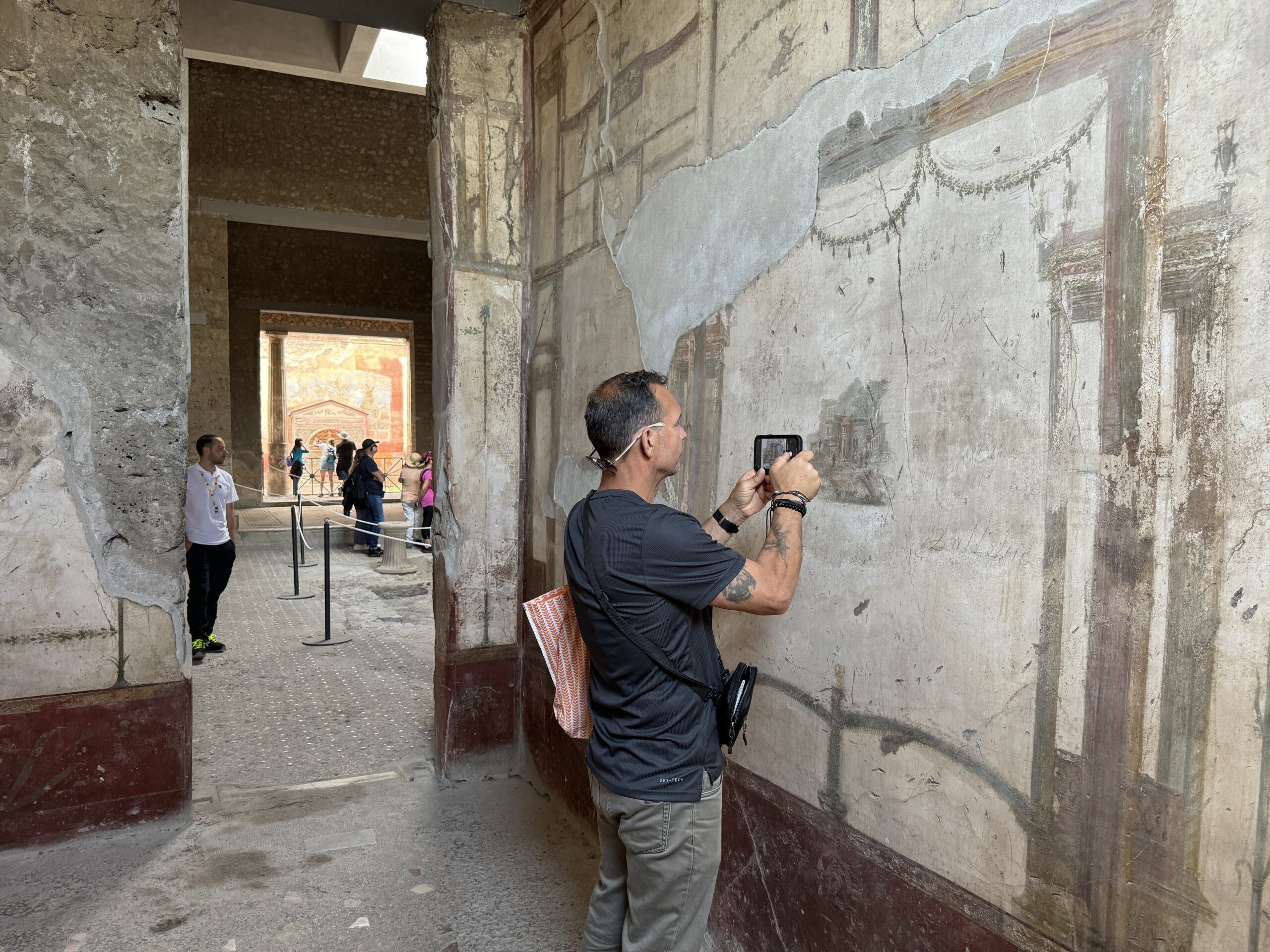
Rome
Love at first, second, and third sight
Ahhh, Rome. You fabulous city. On day one we walked to the Vatican, had coffee and pistachio cornetti, watched police officers play giant chess, then hopped on a bus tour to orient ourselves. After a nap, we headed to Trastevere for dinner—easily one of the coolest neighbourhoods in the city.
Once the swelling and redness had crept all the way up to the wings of Randy’s dragon tattoo, we knew it was time to get medical help. Our apartment host urged us to go to the local hospital, reassuring us there was an international visitors’ clinic. We entered a tiny waiting room with only six seats. At one point, an arm slipped through the door and a voice asked quietly for his passport — then the door clicked shut again. Fifteen minutes later, we were ushered into a small hospital room. We told them exactly what had happened, and I showed the doctor a photo of the cat and she said “awww,” which is not the reaction I was expecting!
When the bill came, she sheepishly told us it would cost 20 euros because we weren’t EU residents. We exhaled in relief.
The next day we continued exploring the city, and we wandered into the opulent Basilica of Santa Maria del Popolo—completely by accident—and found two original Caravaggios inside. I was moved close to tears.
Then came the Leonardo da Vinci museum beneath the church, the parakeets zigzagging around a huge beautiful park, and finally the Pantheon. The light streaming through the oculus left me utterly speechless.
Rome is so much more than the Colosseum and a handful of crumbling ruins. The entire city feels like a living museum layered with centuries of stories, where every corner reveals another architectural marvel, tucked-away basilica, or surprise masterpiece. One minute you’re admiring a Renaissance façade, the next you’re stumbling upon a Caravaggio in a chapel or watching locals chat animatedly outside a café that’s been there longer than your country has even existed. The energy is vibrant, human, and deeply rooted — Romans aren’t just surrounded by history, they live in it. It’s this blend of everyday life and extraordinary beauty that makes the city feel endlessly rich, inviting, and utterly irresistible.
Then, with our Schengen time up, we headed to the UK once more.




